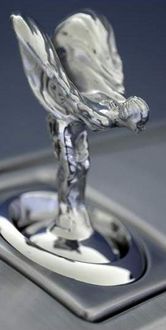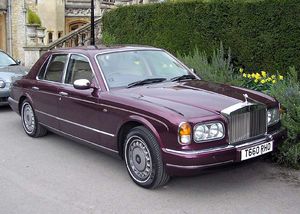.
Rolls-Royce Silver Seraph: Difference between revisions
Red marquis (talk | contribs) |
Red marquis (talk | contribs) No edit summary |
||
| Line 1: | Line 1: | ||
[[Image:Rollsseraph.jpg|thumb|right|300px]] | [[Image:Rollsseraph.jpg|thumb|right|300px]] | ||
The '''Rolls-Royce Silver Seraph''', produced from | The '''Rolls-Royce Silver Seraph''', produced from 1998 to 2002, was first unveiled on March 3, 1998 at the [[Geneva Motor Show]]. The Silver Seraph replaced the [[Rolls-Royce Silver Spur|Silver Spur]], which ended production in 1997. | ||
All Seraphs were hand-built at the [[Rolls-Royce Motors|Rolls-Royce]] factory in | All Seraphs were hand-built at the [[Rolls-Royce Motors|Rolls-Royce]] factory in Crewe, England, which stopped making Rolls Royce models in 2002 but continued with [[Bentley]]. The car had a base price of £155,175 in the UK and $220,695 in the US. It was second in cost and exclusivity only to the [[Rolls-Royce Corniche|Rolls-Royce Corniche]]. | ||
The Seraph was powered by a 5.4 L aluminium alloy [[BMW]] [[V12]] engine and was operated via a 5-speed [[automatic transmission]], making it the first twelve-cylinder Rolls-Royce since the | The Seraph was powered by a 5.4 L aluminium alloy [[BMW]] [[V12]] engine and was operated via a 5-speed [[automatic transmission]], making it the first twelve-cylinder Rolls-Royce since the 1939 [[Rolls-Royce Phantom III|Phantom III]]. Standard electronics included digital engine management, adaptive ride control and anti-lock brakes. | ||
The body was 65 percent stiffer than that of its predecessor. Aside from the radiator grille, badges and wheels, the Rolls-Royce was externally identical to the contemporary [[Bentley Arnage]], sharing both its platform and body shell. Paint was available in one and two-tone finwashes. | The body was 65 percent stiffer than that of its predecessor. Aside from the radiator grille, badges and wheels, the Rolls-Royce was externally identical to the contemporary [[Bentley Arnage]], sharing both its platform and body shell. Paint was available in one and two-tone finwashes. | ||
Inside, the Rolls-Royce Silver Seraph and the Bentley Arnage were similar but quite distinct from one another. In the Seraph, the gear selector was column-mounted and the gauges followed a traditional Rolls-Royce layout (for example, there was no tachometer). In both cars, the seats and dashboard were upholstered in Connolly | Inside, the Rolls-Royce Silver Seraph and the Bentley Arnage were similar but quite distinct from one another. In the Seraph, the gear selector was column-mounted and the gauges followed a traditional Rolls-Royce layout (for example, there was no tachometer). In both cars, the seats and dashboard were upholstered in Connolly leather, with dashboard trim and folding picnic trays for rear passengers faced with glossy burl walnut veneer. | ||
The Seraph was known for its relatively limited acceleration and comfortable handling, in comparison to the Arnage, which had a supercharged BMW V8 and firmer suspension. However, the Seraph still had a top speed of 140 mph. | The Seraph was known for its relatively limited acceleration and comfortable handling, in comparison to the Arnage, which had a supercharged BMW V8 and firmer suspension. However, the Seraph still had a top speed of 140 mph. | ||
A total of 1,570 Silver Seraphs were produced before the car was ceased production. It was indirectly replaced by the [[Rolls-Royce Phantom | A total of 1,570 Silver Seraphs were produced before the car was ceased production. It was indirectly replaced by the [[Rolls-Royce Phantom|Rolls-Royce Phantom]] in 2003. As of 2006, the Bentley Arnage is still being produced by Bentley. | ||
==Gallery== | ==Gallery== | ||
Revision as of 21:46, 7 January 2007
The Rolls-Royce Silver Seraph, produced from 1998 to 2002, was first unveiled on March 3, 1998 at the Geneva Motor Show. The Silver Seraph replaced the Silver Spur, which ended production in 1997.
All Seraphs were hand-built at the Rolls-Royce factory in Crewe, England, which stopped making Rolls Royce models in 2002 but continued with Bentley. The car had a base price of £155,175 in the UK and $220,695 in the US. It was second in cost and exclusivity only to the Rolls-Royce Corniche.
The Seraph was powered by a 5.4 L aluminium alloy BMW V12 engine and was operated via a 5-speed automatic transmission, making it the first twelve-cylinder Rolls-Royce since the 1939 Phantom III. Standard electronics included digital engine management, adaptive ride control and anti-lock brakes.
The body was 65 percent stiffer than that of its predecessor. Aside from the radiator grille, badges and wheels, the Rolls-Royce was externally identical to the contemporary Bentley Arnage, sharing both its platform and body shell. Paint was available in one and two-tone finwashes.
Inside, the Rolls-Royce Silver Seraph and the Bentley Arnage were similar but quite distinct from one another. In the Seraph, the gear selector was column-mounted and the gauges followed a traditional Rolls-Royce layout (for example, there was no tachometer). In both cars, the seats and dashboard were upholstered in Connolly leather, with dashboard trim and folding picnic trays for rear passengers faced with glossy burl walnut veneer.
The Seraph was known for its relatively limited acceleration and comfortable handling, in comparison to the Arnage, which had a supercharged BMW V8 and firmer suspension. However, the Seraph still had a top speed of 140 mph.
A total of 1,570 Silver Seraphs were produced before the car was ceased production. It was indirectly replaced by the Rolls-Royce Phantom in 2003. As of 2006, the Bentley Arnage is still being produced by Bentley.
Gallery
External links
See also

| ||
| ROLLS-ROYCE | ||
|
BMW | Rolls-Royce | Mini Current Models: Phantom (VII) · Drophead · Phantom Coupe · Ghost Historic Models: Silver Seraph · Silver Spur / Flying Spur · Silver Spirit · Silver Shadow · Silver Cloud · Silver Wraith · Silver Dawn · Silver Ghost · 10 HP · 15 HP · 20 HP · 20/25 · 30 HP · 25/30 Wraith · Camargue · Corniche · Phantom I · Phantom II · Phantom III · Phantom IV · Phantom V · Phantom VI · Armoured Car · Legalimit Concept Cars: 1EX · 100EX · 101EX · 200EX Concept Specials: FAB 1 · Cloudesque · Silver Ghost Boat Tail Speedster · Silver Spur Hooper Landaulette · Phantom II Star of India | ||
| Sir Henry Royce and Charles Rolls | Corporate website | A brand of BMW AG |



